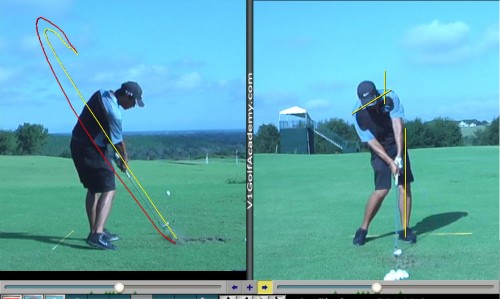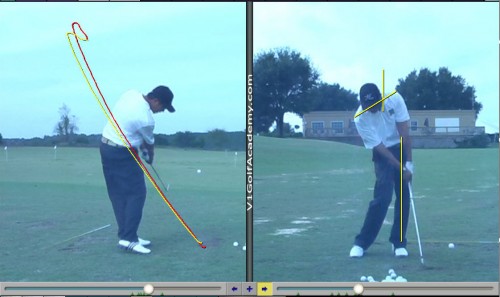I am extremely proud to be working with Hooters Tour Professional Kris Lim. Kris is an extraordinary young man, whose desire to excel is only exceeded by his desire to understand the fundamentals of the golf swing. Kris did not come to the Rotary Swing Golf Academy looking for quick fixes to improve his game immediately; he came to us seeking answers to questions that were not able to be provided to him through “traditional” instruction. He was tired of hearing that his swing looked great; he wanted results. Kris is a prime example of the type of change that is possible through intellectual understanding and kinesthetic awareness that comes as a product of structured practice that focuses on the anatomical absolutes.
In previous forum posts, I provided some examples of how we first began a little over a month ago. We started by addressing Kris’s Setup and perfecting Move 1 (The Takeaway). As these elements improved, we introduced proper shoulder elevation to keep the club working on a proper plane throughout the backswing. Today is November 23, and it was time for some serious business…Move 3 (The Downswing). Kris is a prime example of a golfer who would rotate his hips without ever making a proper weight shift into the left heel. The results of this dastardly movement can be illustrated from the picture below.
On the left side is a trace of Kris’s swing path. The red line represents his backswing, and the yellow line represents his downswing. It becomes quite clear Kris was over the top which resulted in many “wiped” shots that would weakly balloon and fade. On the right side, you can plainly see Kris’s failure to shift that left hip which left him well short of Neutral Joint Alignment. Kris’s weight is now trapped on his right side which results in the excessive axis tilt and his head backing way up as he comes into impact. He never covers the golf ball effectively, and fails to compress or flight the shot the way he desires. Due to his improper origin of movement, the more he would try to cover the ball, the more fat shots he would hit.
Now let’s examine footage from the lesson on November 23. On the left, you can see a significant improvement in Kris’s swing path. The red line represents his backswing, and the yellow line represents his downswing once again, but take note the orientation of the lines are dramatically different. Due to the backswing improvements, Kris takes the club on a much better plane, and is capable of keeping the club in front of his body. A proper weight shift, planting the left heel and pulling from the left oblique allows the club to shallow slightly and attack the ball from the inside (note the yellow downswing line is underneath the red backswing line). On the right half of the picture, you can see Kris’s head has not backed up nearly as much, and the axis tilt is improved. Kris’s left hip has shifted toward the target before he unwinds the hips which allows him to get into NJA at impact.
I want to mention at no time during this lesson did we talk about swing plane or what the club was doing; we focused solely on proper origin of movement in the downswing. The golf swing needs to be based on a pull-pull relationship in order to abide by the laws of physics of rotary motion. Kris serves as an excellent model of what can be achieved by focusing on how the human body is designed to work. While we have lots of work left to do, Kris is finally traveling on the road to success. RST provides the road map for this journey…want to follow along?


















Al,
This issue seems to plague the majority of recreational golfers at some point in time. I know it is my tendency as far as pulls and weak fades and slices. I traced these lines on my swing recently and I can say that Move 3 is something I cannot do consistently. I see the over the top lines in about 1/4 of my swings. The 9 to 3 drill and the new weight shift drills in the RST section were my focus today with very good initial results. I also threw in a left arm only 9 to 3 to focus on pulling efficiently from the left…seems to help when I get too pushy with the right arm coming down. Great demonstration, Al.
Check,
You are on the right track with your practice routine. Many golfers suffer from using their upper bodies to start their downswing which results in an outside-in swing path. Mastering a correct weight shift, pulling from the left side, is a critical element in being able to attack the golf ball from the inside. Al
Al,
I was able to get in about 25 live swings today. I am finding that I really need to pull efficiently from both sides…seems that starting with an effective pull going back almost sets you up to do the same on the way down (duh!). Also, when I get the ‘feeling’ that I am almost not going to make it back to the ball in time with my shoulders and arms, the contact ends up crisp and compressed (and noticeably more shallow from waist high position) . That’s how over the top my swing has gotten. Need hundreds and hundreds more reps of this stuff with and without the ball.
Al,
Great article, and shows the good work Kris and you have put in.
The impact transformation is remarkable, with much better ‘posting’ on the left leg and looks like better lower body rotation. You can just sense the ball flight with better penetration.
I can’t wait for the next installment.
Matt
Matt,
I am very proud of Kris and his dedication to learning the fundamentals. He has taken the time to pay attention to the correct origins of movement instead of worrying about the club or hitting all the “correct” positions.
Al